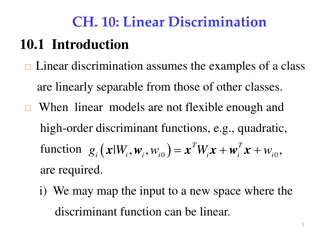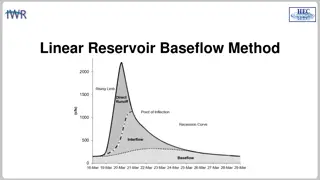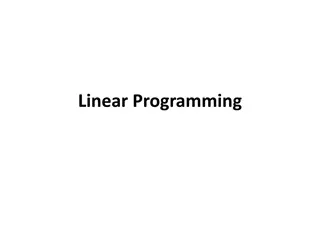
Understanding the Wronskian Function in Mathematics
Explore the concept of the Wronskian function, its significance in differential equations, and how it determines linear dependence or independence of solutions. Examples illustrate the application of the Wronskian in determining the relationship between different functions.
Download Presentation

Please find below an Image/Link to download the presentation.
The content on the website is provided AS IS for your information and personal use only. It may not be sold, licensed, or shared on other websites without obtaining consent from the author. If you encounter any issues during the download, it is possible that the publisher has removed the file from their server.
You are allowed to download the files provided on this website for personal or commercial use, subject to the condition that they are used lawfully. All files are the property of their respective owners.
The content on the website is provided AS IS for your information and personal use only. It may not be sold, licensed, or shared on other websites without obtaining consent from the author.
E N D
Presentation Transcript
The Wronskian function: linear dependence and independence Dr. Aruna Kulkarni
In mathematics, the Wronskian is a determinant introduced by Jozef Hoene- Wronskian. It is used in the study of differential equations. It shows linear independence in a set of solutions.
Consider the equation L(y)=0 Where L(y) = ? + ?1? + ?2? = 0 If 1??? 2are two solutions of above equation then Wronskian W( 1, 2) is defined as
? 1,2 = 12 1 2 = 1 2 1 2 It is a function , and its value at x is denoted by ?( 1, 2)(?).
Theorem Two solutions 1, 2,?? L(y) = 0 are linearly independent on an interval I if, and only if, ? 1, 2 ? 0 for all x in I.
The functions 1,2defined in following examples exist for < ? < . Determine whether they are linearly dependent or independent there. [I] 1? = ?, 2(?) = ?2? Solution: we have 1? = ?, 2(?) = ?2? then 1(x)= 1 and 2(x)= 2?2? W( 1, 2)= 1 2 ? ?2? 1 2?2? = 2??2? ?2?= ?2?(2? 1) 0 L.I. 1 2 =
[II] 1? = cos?, 2(x)=sin? Solution: from above we get 1? = ????, 2(x)=cos? W( 1, 2)= 1 2 = cos? sin? sin? cos?= cos2? +sin2? = 1 value of determinant is not zero so they are linearly independent. 1 2
[III] 1? = ?2, 2(x)=5?2 solution: from above we have 1= 2x, 2= 10x ?( 1, 2)= 1 2 1 2 = 10?3 10?3 = 0 so they are linearly dependent. =?25?2 2? 10?
[IV] (?) = ??? 1? = ????, 2 Solution: from above we have 1? = ????, ?( 1, 2)= sin? ??? = ???????? ???? = ???? + ????? ????? ???? = ????? + ???? ????? ???? = ?2???2? ???2x = -???2? ???2x = (???2? + ???2x) = -1 0 ?? are linearly independent. 2? = ???? cos? ????
Assignment 1? = ????, 2(x)= 3(???+ ? ??). Thank You.






















